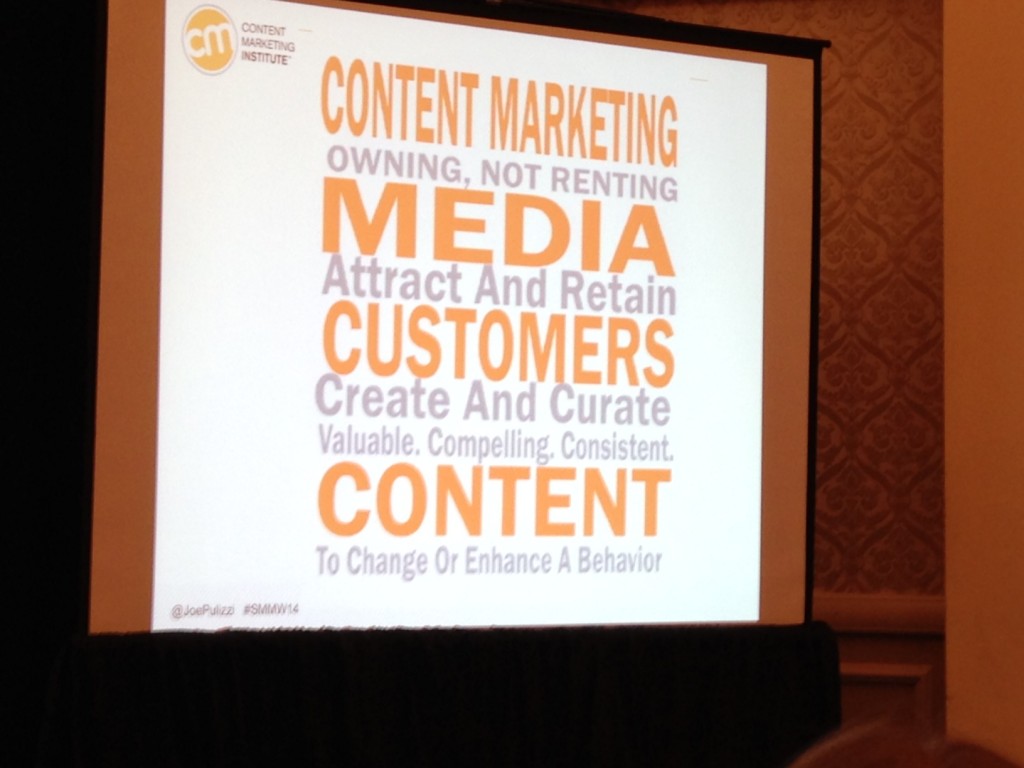
(Image credit: @aaronnak)
George Carlin famously said, the goal of human beings is to acquire stuff, then to store it somewhere.
Unfortunately, many businesses have treated their corporate content the same way, as stuff to be acquired, and used their websites, blogs, and social channels as the places to store it.
‘If we only talk about ourselves, we’ll never reach customers’ says the always entertaining Joe Pulizzi in his packed-room presentation at Social Media Marketing World 2014.
The answer to this pathological content hoarding problem is content marketing, or at least it was supposed to be. Unfortunately, many businesses are not following important content marketing best practices and are seeing disappointing results because of it. According to research from Content Marketing Institute, 90% of businesses today are engaging in content marketing, but only 45% report it to be effective.
Here are 5 essential content marketing best practices businesses need to follow if they want to get the ROI that’s missing from their content marketing:
Consider the Desired Outcome from Your Content: Sales, Savings or Sunshine?
Before creating any content, businesses need to ask why? The all too common practice is to dive in before figuring this out. The unfortunate result is content that doesn’t achieve objectives, simply because no objective was decided beforehand. Like a ship without a rudder, this won’t get you anywhere fast.
In order for content to achieve business objectives, content marketers need to think in the same terms as their CMO:
- Sales – content that generates revenue
- Savings – content that saves money
- Sunshine – content that makes your customers feel good
Anything else should be considered a secondary objective or not considered at all.
It’s also important to consider the ‘why’ for each distribution channel you are considering promoting your brand content to. If you cannot come up with a compelling reason, you can bet your customers won’t either.

Create a Content Marketing Mission Statement
Having a well thought out mission statement is essential to getting value from your content marketing investment. It should at minimum contain:
- Audience – Who is your core target audience?
- Niche – What will your content deliver to them?
- Goal – What is the desired outcome for your audience (not for your company)?
As Joe explained, having a clear mission statement is helpful to your team because it tells them what not to create. As smart as your content team is, they won’t inherently know this unless it’s spelled out via a mission statement. With only 20% of businesses having a documented content marketing strategy, this is a major opportunity for many.
When putting together your mission statement, always resist the urge to be broad. With the incredible volume of content freely available on the internet, users have come to expect very relevant and specific answers to their questions, and broad content isn’t going to fit the bill here. By narrowing your focus as much as possible, your brand can effectively own your niche by consistently being the best answer.
A great example is Proctor & Gamble’s Home Made Simple blog, which has the documented mission statement ‘enabling women to have more quality time with their families’. They have clearly and concisely explained their core target audience (women), niche (tips for the home) and goal (to give their audience more time to spend with the family). Interested in a multi-step recipe that takes all day to make? Better look elsewhere, this content is about saving time!

Don’t Build Your Content Hub on Rented Land
Social channels, industry publications, and other external networks are a great way to promote your brand’s content, but you should put the majority of your investment in an area that you own and control, like your website and blog.
Marketers and businesses received a painful reminder of the importance of having control over their control hubs when Facebook changed their Newsfeed Algorithm to significantly reduce the organic reach of pages. This move to a pay-to-play model after years of brands helping to build Facebook into the mega-platform it is today has understandably left a very bad taste for many, and hopefully won’t be a lesson we’ll need to repeat.
In order to insure ownership over your content hub while taking advantage of the incredible amplification power of social networks, you should always have the end goal of attracting your customers to a platform you own, where you can provide consistent value through content that breeds engagement, conversion and advocacy. As Joe says, ‘focus on subscribers as your KPI’.
Leverage Influencers to Build an Audience
Here at TopRank, we have been advocates for the power of influencers in content marketing for a long time, and we’re in good company with Joe on that belief.
Including influencers in your content is extremely effective in extending its reach because it exposes it to new (and usually much larger) audiences outside your subscriber base. In addition, having your content associated with subject matter experts in your industry helps to boost its perception of credibility and authority.
A great example of successful influencer integration is Content Marketing Institute’s Content Marketing Playbook. Over 50,000 downloads is impressive on its own, but particularly considering that at the time CMI had a subscriber base of only 3,000.
Build vs Buy
Building an audience from scratch takes a lot of time an effort. An increasingly attractive option for many businesses is to purchase audiences from others who have already taken the time to build a large subscriber base in your industry.
Purchasing pre-built audiences is a great opportunity to expedite the community building process and get your content in front of more eyes much faster, and it can often be done on the cheap. For example, the online camera retailer Adorama recently purchased the near bankrupt JPG Media Company, dramatically increasing their audience for a great price. Joe predicts that ‘2014 may be the year the media companies go away as brands buy them’.
Are you getting disappointing results from your content marketing?
Maybe it’s time to take a good hard look at your processes and make sure you are following these best practices. Content marketing done right creates magical experiences for your customers, meets and exceeds business objectives and is tons of fun!
What are your most valuable content marketing best practices?


